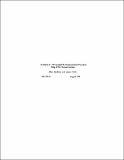| dc.contributor.author | Kaufman, Alan | en_US |
| dc.contributor.author | Orlin, James B., 1953- | en_US |
| dc.date.accessioned | 2004-05-28T19:33:52Z | |
| dc.date.available | 2004-05-28T19:33:52Z | |
| dc.date.issued | 1994-08 | en_US |
| dc.identifier.uri | http://hdl.handle.net/1721.1/5326 | |
| dc.description.abstract | Cohen and colleagues [1] recently described a project to characterize a human yeast artificial chromosome (YAC) library and offered a 'proposed data analysis strategy' that was said to yield a physical map covering 87% of the human genome. The authors provided no analytical evaluation to test the validity of their novel strategy for constructing 'paths' in the genome. We have now examined the proposed method in detail. Analytical studies show that most paths with at most two YACs or spanning less than 5 cM are valid, but most paths involving four or more YACs or spanning 5 cM or more are invalid. After restricting the map to paths with a high probability of being valid, we conclude that the remaining map properly covers at most 36% of the genome. | en_US |
| dc.format.extent | 463844 bytes | |
| dc.format.mimetype | application/pdf | |
| dc.language.iso | en_US | en_US |
| dc.publisher | Massachusetts Institute of Technology, Operations Research Center | en_US |
| dc.relation.ispartofseries | Operations Research Center Working Paper;OR 295-94 | en_US |
| dc.title | Analysis of a Proposed First Generation Physical Map of the Human Genome | en_US |
| dc.type | Working Paper | en_US |
